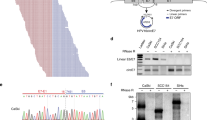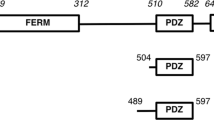Abstract
The conserved region 3 (CR3) of the E7 protein of human papillomaviruses contains two CXXC motifs involved in zinc binding and in the homodimerization of the molecule. Studies have suggested that the intact CXXC motifs in the CR3 of HPV16 and HPV18 E7 are required for the in vitro transforming activity of these proteins. CR3 also contains a low affinity pRb binding site and is involved in the disruption of the E2F/Rb1 complex. E7 is structurally and functionally related to Adenovirus E1A protein, which also has two CXXC motifs in CR3. However, the Ad E1A transforming activity appears to be independent of the presence of such domains. In fact, this viral protein exists in vivo as two different forms of 289 and 243 amino acids. The shorter Ad E1A form (Ad E1A243), where both CXXC motifs are deleted by internal splicing, retains its in vitro transforming activity. We have investigated if the HPV16 E7 CR3 can be functionally replaced by the Ad E1A243 CR3, which lacks both CXXC motifs. A chimeric protein (E7/E1A243) containing the CR1 and CR2 of HPV16 E7 fused to the CR3 of Ad E1A 243 was constructed. The E7/E1A243 while not able to homo-dimerize in the S. cerevisiae two-hybrid system retains several of the properties of the parental proteins, HPV16 E7 and Ad E1A. It associates with the `pocket' proteins, induces growth in soft agar of NIH3T3 cells and immortalizes rat embryo fibroblasts. These data suggest that the CXXC motifs in CR3 of E7 do not play a direct role in the transforming properties of this viral protein but probably are important for maintaining the correct protein configuration.
This is a preview of subscription content, access via your institution
Access options
Subscribe to this journal
Receive 50 print issues and online access
$259.00 per year
only $5.18 per issue
Buy this article
- Purchase on Springer Link
- Instant access to full article PDF
Prices may be subject to local taxes which are calculated during checkout
Similar content being viewed by others
Author information
Authors and Affiliations
Rights and permissions
About this article
Cite this article
Braspenning, J., Marchini, A., Albarani, V. et al. The CXXC Zn binding motifs of the human papillomavirus type 16 E7 oncoprotein are not required for its in vitro transforming activity in rodent cells. Oncogene 16, 1085–1089 (1998). https://doi.org/10.1038/sj.onc.1201617
Received:
Revised:
Accepted:
Published:
Issue Date:
DOI: https://doi.org/10.1038/sj.onc.1201617
Keywords
This article is cited by
-
Reciprocal transactivation of Merkel cell polyomavirus and high-risk human papillomavirus promoter activities and increased expression of their oncoproteins
Virology Journal (2021)
-
Solution structure of the partially folded high-risk human papilloma virus 45 oncoprotein E7
Oncogene (2006)
-
Onzin, a c-Myc-repressed target, promotes survival and transformation by modulating the Akt–Mdm2–p53 pathway
Oncogene (2005)
-
Biological activities and molecular targets of the human papillomavirus E7 oncoprotein
Oncogene (2001)



